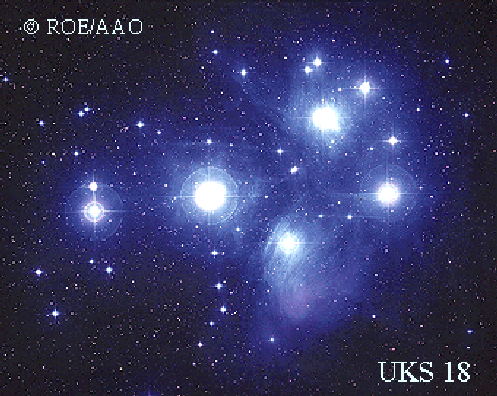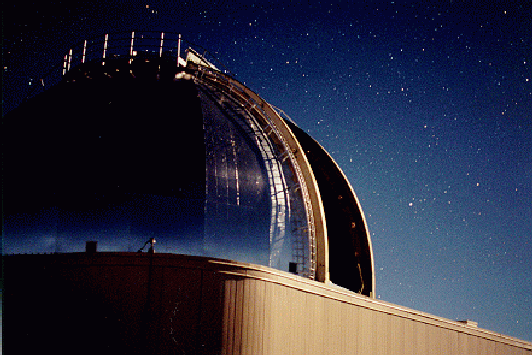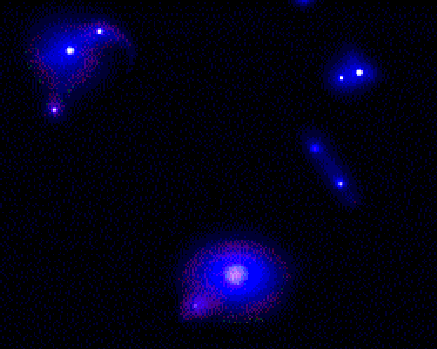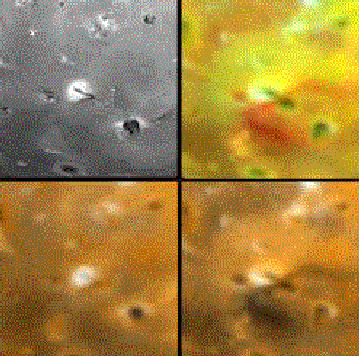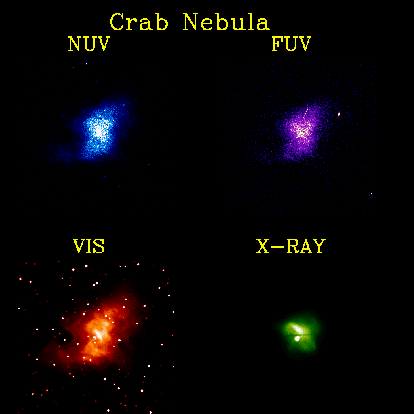NASA APOD #442-450
#442 Tomorrow's picture: September 03, 1996
“It is the most famous star cluster on the sky. The Pleiades can be seen without binoculars from even the depths of a light-polluted city. Also known as the Seven Sisters and M45, the Pleiades is one of the brightest and most easily visible open clusters on the sky. The Pleiades contains over 3000 stars, is about 400 light years away, and only 13 light years across. Quite evident in the above photograph is the blue reflection nebula that surrounds the bright cluster stars. Low mass, faint, brown dwarfs have recently been found in the Pleiades."
Copyright: Royal Observatory, EdinburghAnglo-Australian
Observatory
#443 Tomorrow's picture: September 04, 1996
“Above, NASA's Infrared Telescope Facility (IRTF) poses in front of a starry background. Located on top of Hawaii's towering volcano Mauna Kea, the IRTF is the premier telescope for observing in near infrared light. This 3-meter telescope was established in 1979 and spends about half its time observing Solar System objects. In 1994, for example, the IRTF recorded pieces of the famous comet Shoemaker-Levy 9 plunge into Jupiter. Last year, the IRTF recorded an outburst of a volcano on Jupiter's moon Io. IRTF's observational successes outside our Solar System include understanding the infrared emission of dust and Pre-Main Sequence stars and even the identification of faint galaxies."
Copyright: Public domain
#444 Tomorrow's picture: September 05, 1996
“ Snips and snails and puppy dog tails, is that what galaxies were made of? In a report released yesterday and soon to be published in Nature, astronomers have imaged an interesting distant patch of sky with the orbiting Hubble Space Telescope. They found many merging groups of stars and gas which have been dubbed "pre-galactic blobs." A particularly dense bunch of these small blue merging objects are visible in the above picture. This may be a snapshot of galaxies actually being formed! Although peculiar by present standards of galaxies, these blobs may have been normal in the distant past, many billions of years ago. This adds evidence that galaxies formed from the conglomeration of smaller objects instead of the fragmentation of larger objects. "
Copyright: Public domain
#445 Tomorrow's picture: September 06, 1996
“ What is the largest known impact crater in the Solar System? Over 1300 miles across, the South Pole-Aitken Basin on the farside of Earth's Moon holds that distinction. Circled above in a false color mosaic of Clementine images it was caused when an asteroid or comet sized object crashed into the surface, penetrating the lunar mantle. In general, the rocky terrestrial planets and moons are scarred and battered from frequent repeated bombardment by large objects during our Solar System's early years. On Earth, continuous geological activity has hidden much of the damage, but the surface of the smaller, less active Moon bears testimony to a shared history of fierce and frequent impacts. At the present time in the vicinity of Earth, the bombardment continues - fortunately at a greatly reduced rate. "
Copyright: Public domain
#446 Tomorrow's picture: September 07, 1996
“ What did the universe look like two billion years after the Big Bang? According to this computer model, the universe was filled with irregular looking objects like the ones shown above. The simulation then predicts that these blobs of stars and gas collide to form galaxies more similar to the ones we see today. In fact, this simulation bears much resemblance to recent pictures of distant galaxies taken by the Hubble Space Telescope. Galaxy formation is a complex phenomena which only now is becoming understood. Did most galaxies form 5 billion years ago - or 10 billion? Did galaxies fragment from larger sheets of matter, or are they conglomerations of many smaller clumps? Simulations like this one are helping to determine the answer. "
Copyright: Public domain
#447 Tomorrow's picture: September 08, 1996
“Jupiter's moon Io is turning out to be our Solar System's geologic powerhouse. The churning moon was photographed again just recently on June 27th and again shows signs of violent activity. Shown above are photographs of the volcano Euboea Fluctus taken at different times. The black and white photograph on the upper left was taken by the Voyager 1 spacecraft when it flew by in 1979, the upper right and lower left photographs were taken in 1996 by the Galileo spacecraft, while the lower right photograph is a color image taken by Voyager 2, also in 1979. The upper right Galileo picture has been artifically changed to simulate the color sensitivity of the Voyager 2 mission. The marked difference in the two images is highlighted by new red and yellow deposits. These markings may indicate that Euboea Fluctus erupts in an unusual fashion, possibly caused by an obstruction near the volcanic vent. "
Copyright: Public domain
#448 Tomorrow's picture: September 09, 1996
“ This is the mess that is left when a star explodes. The Crab Nebula is so energetic that it glows in every kind of light known. Shown above are images of the Crab Nebula from visible light to the X-ray band. NUV stands for "near ultraviolet" light, FUV means "far ultraviolet" light, and VIS means visible light. In the center of the Crab Nebula lies the powerful Crab pulsar - a spinning neutron star with mass comparable to our Sun but with the diameter of only a small town. The pulsar expels particles and radiation in a beam that sweeps past the Earth 30 times a second. The supernova that created the Crab Nebula was seen by ancient Chinese astronomers and possibly even the Anasazi Indians -- in 1054 AD, perhaps glowing for a week as bright as the full moon. The Crab still presents mysteries today as the total mass of the nebula and pulsar appears much less than the mass of the original pre-supernova star! "
Copyright: Public domain
#449 Tomorrow's picture: September 10, 1996
“ Why is M77 surrounded by an ultraviolet glow? M77, also called NGC 1068, appears at first sight to be a relatively normal barred spiral galaxy. But when photographed in the ultraviolet (UV), as shown above in false color, the galaxy sports an ultraviolet halo - shown as violet in the photograph. The blue spiral structure closer to the picture's center indicates normal ultraviolet emission from bright young stars that have recently formed there. Astronomers now hypothesize that the outer glow arises from UV light emitted from the galaxy's active center and reflected to us from clouds of gas and dust. These same gas and dust clouds obscure the active center of this Seyfert galaxy - where an ultramassive black hole is thought to live. "
Copyright: Public domain
#450 Tomorrow's picture: September 11, 1996
“ What is happening in the center of nearby spiral galaxy M77? To find out, astronomers used the Hubble Space Telescope to peer deep into the dusty chaos of this active galactic nucleus in 1994. They found a network of filamentary gas and opaque dust that provides only clues as to what central monster had left this mess. Due to the presence of hot ionized gas clouds near the core, changes in brightness that can take less than a week, and the ultraviolet halo surrounding the whole galaxy, the leading hypothesis is that a supermassive black hole lies at the center of this Seyfert Type 2 galaxy. Also known as NGC 1068, this galaxy lies only about 50 million light years distant and is visible with only a small telescope. "
Copyright: Public domain
Upvote! Resteem! Comment! As you like it! Thank you for attention!
